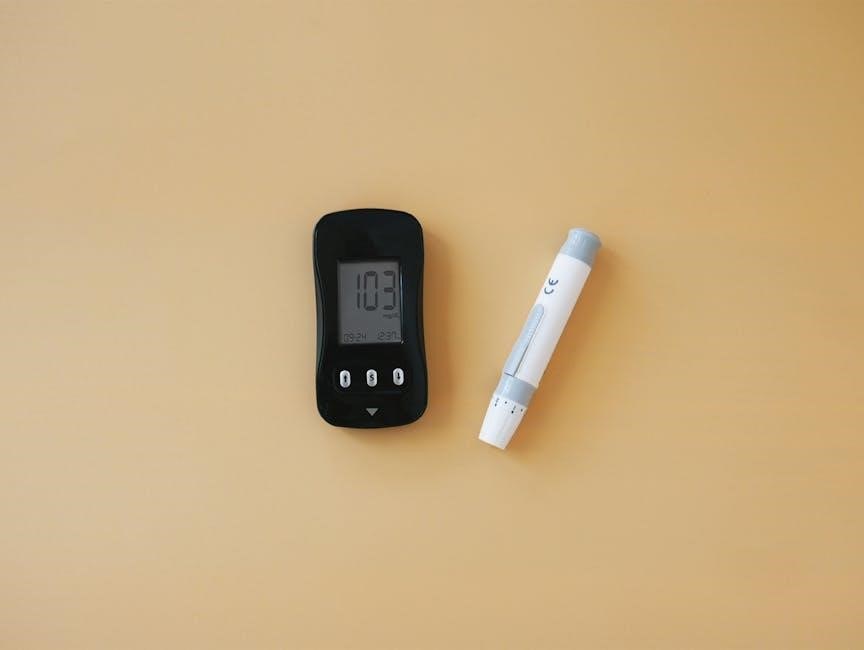The Childhood Asthma Control Test (C-ACT) is a validated tool for assessing asthma control in children aged 4-11, helping evaluate symptom management and treatment effectiveness․
1․1 Purpose of the Test
The Childhood Asthma Control Test (C-ACT) is designed to assess asthma control in children aged 4-11, helping determine if symptoms are well-managed and if the treatment plan is effective․ It evaluates the child’s asthma symptoms, their impact on daily activities, and the need for rescue medication․ The test provides insights into whether asthma is controlled or if adjustments to the treatment plan are necessary, aiding healthcare providers in making informed decisions․

1․2 Importance of Assessing Asthma Control in Children
Assessing asthma control in children is crucial for preventing exacerbations, improving quality of life, and reducing healthcare costs․ Uncontrolled asthma can lead to missed school days, sleep disturbances, and increased emergency visits․ Regular evaluation with tools like the C-ACT helps identify issues early, ensuring timely adjustments to treatment․ This proactive approach supports better symptom management, enhances physical activity participation, and fosters a healthier environment for children to thrive․
Administration of the Childhood Asthma Control Test (C-ACT)
The C-ACT is designed for children aged 4-11 and involves both parent and child participation․ It is a straightforward, easy-to-complete assessment tool․
2․1 How to Take the Test
Children aged 4-11 take the C-ACT with parental assistance․ The test focuses on asthma symptoms over the past 4 weeks․ Parents help their child understand questions, ensuring accurate responses․ The test is completed together, with parents providing input where needed․ It is designed to be quick and easy, typically taking only a few minutes․ Results are then discussed with healthcare providers to assess asthma control and guide treatment adjustments․

2․2 Age Range and Eligibility
The Childhood Asthma Control Test (C-ACT) is specifically designed for children aged 4 to 11 years․ It is validated for this age group to ensure accurate assessment of asthma control․ The test is intended for children who can understand and respond to simple questions, with parental assistance if needed․ Eligibility includes children diagnosed with asthma, making it a valuable tool for pediatric asthma management․ It is not suitable for younger children or those unable to communicate effectively․ This age range ensures reliability and relevance for young patients․
2․3 Role of Parents and Guardians in Completing the Test
Parents or guardians play a crucial role in assisting children aged 4-11 with the Childhood Asthma Control Test (C-ACT)․ They help interpret questions and ensure accurate responses, especially for younger children․ The test includes both parent-reported and child-reported questions, requiring collaboration․ Parents provide insights into the child’s symptoms and behavior, which are essential for an accurate assessment․ Their involvement ensures the test reflects the child’s asthma control effectively, aiding healthcare providers in making informed decisions․

Interpreting the Results of the C-ACT
The C-ACT score ranges from 0 to 27, with higher scores indicating better asthma control․ A score of 19 or less suggests poor control, guiding treatment adjustments․
3․1 Scoring System and Thresholds
The Childhood Asthma Control Test (C-ACT) uses a scoring system ranging from 0 to 27, with higher scores indicating better asthma control․ A score of 19 or above suggests well-controlled asthma, while scores below 19 indicate poorly controlled symptoms․ The test evaluates factors like coughing, wheezing, shortness of breath, and nighttime awakenings․ These thresholds help healthcare providers assess symptom severity and guide treatment decisions, ensuring personalized care for children with asthma․
3․2 Implications of High vs․ Low Scores
A high score (≥19) on the C-ACT indicates well-controlled asthma, reducing the risk of exacerbations and improving quality of life․ Scores below 19 suggest poor control, linking to increased symptoms, hospital visits, and complications․ Low scores prompt healthcare providers to reassess treatment plans, potentially adjusting medications or therapies․ High scores confirm effective management, while low scores highlight the need for interventions to achieve better asthma control and reduce long-term risks for children․

The Role of C-ACT in Asthma Management
The Childhood Asthma Control Test (C-ACT) plays a crucial role in asthma management by guiding treatment adjustments and monitoring asthma control over time in children aged 4-11․
4․1 Guiding Treatment Plans

The Childhood Asthma Control Test (C-ACT) is instrumental in guiding treatment plans by assessing asthma control in children aged 4-11․ Scores from the test help identify whether current therapies are effective or if adjustments are needed․ A low score (≤19) may indicate poor control, prompting healthcare providers to consider stepping up treatment, such as increasing medication or adding new therapies․ Conversely, high scores suggest well-managed asthma, allowing for potential reductions in treatment intensity․ Regular use of the C-ACT ensures tailored and adaptive care․
4․2 Monitoring Asthma Over Time

The Childhood Asthma Control Test (C-ACT) serves as a valuable tool for monitoring asthma control over time in children aged 4-11․ Regular administration of the test allows healthcare providers to track changes in asthma symptoms and treatment effectiveness․ High scores indicate sustained control, while declining scores may signal worsening symptoms or the need for treatment adjustments․ This longitudinal approach ensures timely interventions, aligning with recommendations from guidelines like GINA, and supports better long-term asthma management․

Validation and Reliability of the C-ACT
The Childhood Asthma Control Test (C-ACT) is widely validated and reliable for assessing asthma control in children aged 4-11, supported by studies and guidelines like GINA․
5․1 Studies Supporting Its Use
The Childhood Asthma Control Test (C-ACT) is validated and reliable, supported by multiple studies demonstrating its effectiveness in assessing asthma control in children aged 4-11․ Research highlights its ability to predict asthma exacerbations and correlate with clinical measures like spirometry․ Studies by authors such as Ovsyannikova and Chuchalin confirm its practicality for both clinical and research settings, making it a trusted tool for evaluating asthma management in pediatric populations․
5․2 Recommendations from Guidelines (e․g․, GINA)
The Global Initiative for Asthma (GINA) recommends the use of validated tools like the Childhood Asthma Control Test (C-ACT) for assessing asthma control in children; GINA guidelines emphasize the importance of regular monitoring and standardized assessments to guide treatment decisions․ The C-ACT aligns with GINA’s strategies for improving asthma management and ensuring better outcomes for pediatric patients, making it a widely endorsed tool in clinical practice and asthma care pathways․
The Effectiveness of the C-ACT in Improving Asthma Control
The C-ACT effectively improves asthma management by enabling targeted treatment adjustments, leading to enhanced symptom control and better health outcomes for children in regular clinical practice․
6․1 Reducing Exacerbations and Symptoms
By identifying poorly controlled asthma through the C-ACT, healthcare providers can adjust treatments, reducing the frequency and severity of exacerbations․ Studies show a significant decline in symptoms, improving quality of life․ The test’s insights help tailor therapies, minimizing hospital visits and enhancing long-term asthma management․ Regular use of the C-ACT ensures consistent monitoring, preventing sudden flare-ups and maintaining stable asthma control in children aged 4-11․
6․2 Enhancing Quality of Life for Children
Effective asthma control, as identified by the C-ACT, significantly enhances children’s quality of life by reducing symptoms and minimizing disruptions․ Improved control allows children to participate fully in physical activities, sleep better, and experience fewer emotional distresses related to asthma․ By addressing uncontrolled symptoms early, the C-ACT helps children maintain normal daily routines, fostering better overall well-being and long-term health outcomes․ This tool empowers families and healthcare providers to create tailored plans that promote a healthier, more active lifestyle for children with asthma․
Practical Steps for Parents and Healthcare Providers
Parents and providers should discuss C-ACT results with doctors, adjusting treatment plans to improve asthma control and ensure effective symptom management for children aged 4-11․
7․1 Discussing Results with the Doctor

Parents should bring the completed C-ACT to the doctor to discuss results․ The doctor will interpret the score, determine if asthma is well-controlled, and adjust the treatment plan accordingly․ A score of 19 or less indicates poor control, prompting further evaluation․ Open communication ensures personalized care, addressing specific needs and optimizing symptom management for children aged 4-11․ This collaboration enhances asthma control and improves quality of life․
7․2 Adjusting Treatment Based on Test Outcomes
Based on the C-ACT results, doctors may modify the treatment plan to improve asthma control․ Low scores (≤19) often lead to increased medication or frequency, while high scores (≥20) confirm effective management․ Parents and healthcare providers collaborate to adjust therapies, ensuring the child’s asthma is well-managed․ Regular monitoring and tailored adjustments enhance long-term control, reducing exacerbations and improving quality of life for children aged 4-11․ This iterative process ensures personalized and effective asthma care․
The Childhood Asthma Control Test (C-ACT) is a vital tool for assessing and managing asthma in children aged 4-11․ By providing actionable insights, it helps tailor treatment plans, monitor progress, and improve quality of life․ Regular use of the C-ACT ensures personalized care, enabling effective long-term asthma management and better health outcomes for children․
